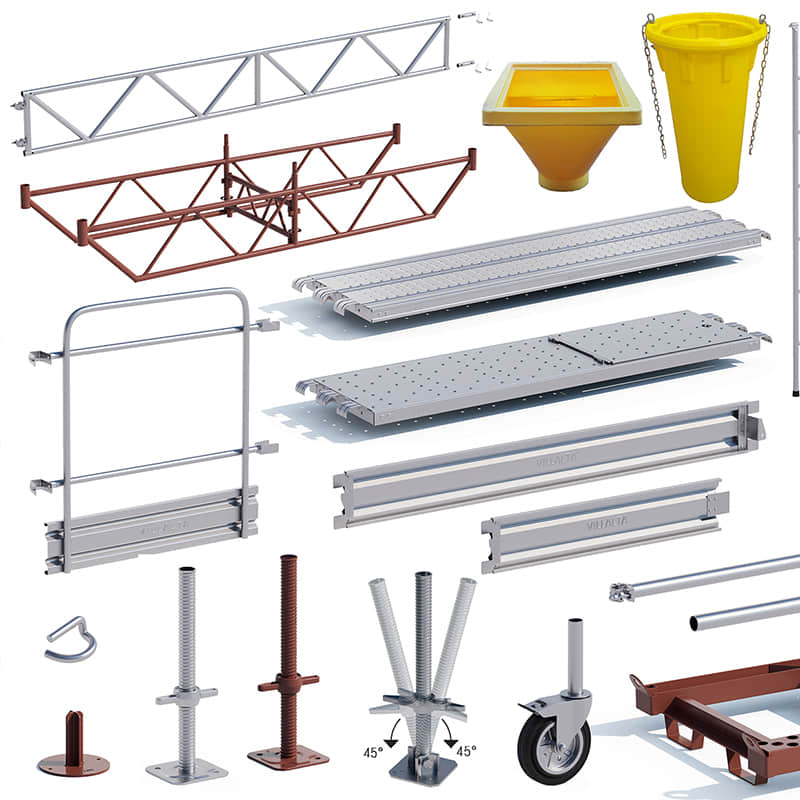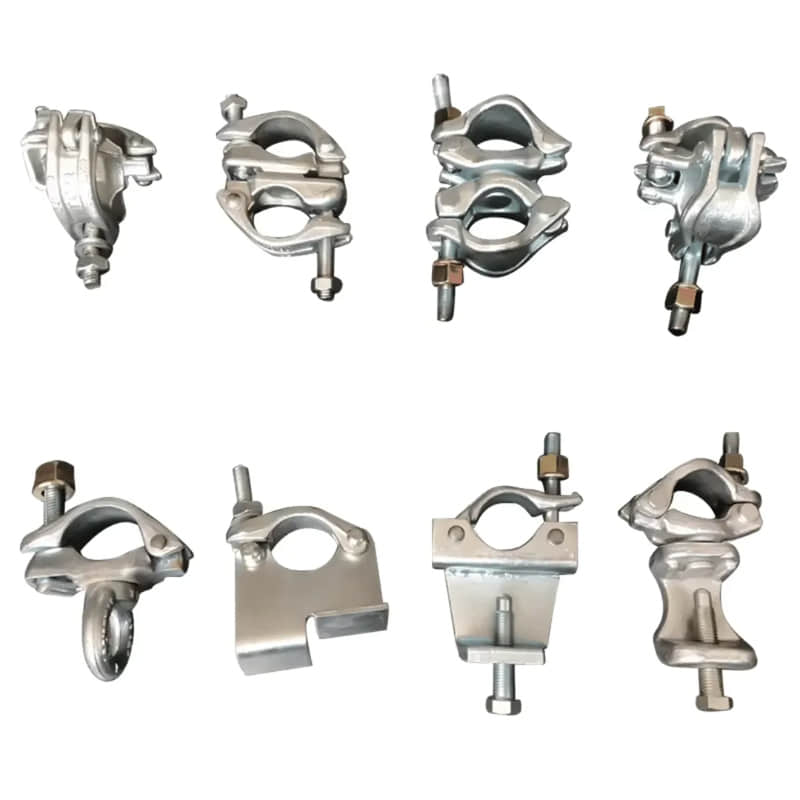Types And Uses Of Scaffolding Equipment
Jul 16, 2024
Construction scaffolding is a temporary structure at a construction site that is put up to help workers and supplies in high-altitude construction projects. It provides a safe and reliable base for construction workers to perform some kind of construction, renovation and maintenance operations efficiently and in small places. It's not just used to build the facade, but also for interior remodeling, installing electrical fixtures or other projects that involve work in the air.
The Main Components Of Scaffolding Equipment
1. Pole
The pole , also known as the standard, is the vertical support part of the scaffolding, carrying the vertical load of the entire structure. The pole is usually made of steel pipe, and its main function is to support the weight of the entire scaffolding and the load of construction personnel and materials above. The height of the pole can be adjusted and connected according to construction needs to ensure the stability and safety of the scaffolding.
Poles are usually made of steel or aluminum, and if they are steel, they are either powder coated or galvanized. Poles come in a variety of sizes, with a standard outside diameter of 48.3 mm. The main difference between the two metal poles is the lighter weight of the aluminum tube.
2. Ledgers
The ledgers include large ledgers and small ledgers, which are important scaffolding components that connect the vertical poles and provide horizontal support. The large ledgers is installed horizontally between the vertical poles to strengthen the scaffolding structure; the small ledgers connects the vertical poles and the large ledgers to further enhance the stability of the scaffolding. The installation of the ledgerss needs to be ensured to be firm to prevent the structure from loosening.
The size of the ledgers is usually determined according to the design and requirements of the scaffolding system. The length of the standard ledgers usually corresponds to the width of the scaffolding board to ensure the stability and balance of the entire scaffolding structure.
3. Diagonal Bracing
Diagonal braces are used to enhance the overall stability of the scaffolding and prevent it from tilting or collapsing during use. Diagonal braces are usually installed between the vertical poles and the horizontal poles at a certain angle to increase the scaffolding's ability to resist lateral forces by increasing the rigidity of the structure. Proper installation of diagonal braces can effectively disperse the load and increase the safety of the scaffolding.
· Internal diagonal brace : located on the inside of the scaffolding, connected between adjacent vertical poles and horizontal poles.
· External braces : Located on the outside of the scaffold, usually used to provide additional support and stability.
4. Scaffolding Board
Scaffolding board is a platform for workers to walk and work on the scaffolding, usually made of wood or steel. Scaffolding should have sufficient strength and anti-slip properties to ensure the safety of workers when working at height. When installing scaffolding, make sure it is stable and firm, and check its status regularly to prevent breakage or displacement.
The size of the scaffolding board is usually determined by the design and requirements of the scaffolding system. The standard size is usually 2.5 meters long and 0.3 meters wide.
5. Base
The base is an important scaffolding accessories, used to support and fix the scaffolding poles. The base is usually made of steel plates and placed on the ground to distribute the load of the poles; the base is generally adjustable to adjust the height and level of the scaffolding. Correct base setting is the key to ensure the stability and safety of the scaffolding.
Scaffolding bases are suitable for ring lock scaffolding, Kwikstage scaffolding, cup lock scaffolding, scaffolding frame, tube and clamp scaffolding systems.
The uprights or standards should be fitted to a steel base and this base should be a minimum of 150mm x 150mm x 6mm. This steel base should be used in all ground and concrete floor conditions and be a part of the tower, it should not be an optional extra.
6. Couplers And Clamps
Couplers and Clamps are actually scaffolding material used to assemble fixed scaffolding. Fixed scaffolding is a type of scaffolding that is assembled by connecting steel pipes with couplers.
It includes two components: load-bearing and non-load-bearing:
Double Coupler
two 48.3mm diameter steel pipes at a fixed right angle to resist tensile or compressive loads.
Swivel Coupler
Connect two steel pipes with a diameter of 48.3 mm at any angle
Single Coupler
Designed to secure putlogs and transoms to ledgers, but this accessory is not intended for load bearing.
Sleeve Coupler
Connect the two steel pipes end to end
Gravlok Coupler
Connect the steel pipe to the beam or crossbeam at a 90 degree angle
7. Protective Equipment And Safety Nets
Protective nets and safety nets are an important safety measure to protect workers and ensure that tools and materials do not fall from high places. At the same time, they can prevent accidents from happening, protect workers an isolate them. Protective nets are usually installed around the scaffolding to protect and isolate the workers, while the safety net is installed under the scaffolding in case a worker falls onto it. Proper installation and use of safety nets and protective nets can effectively reduce construction risks.
8. Ladders And Walkways
Ladders and walkways, which are accessed and used by employees, are means by which a vertical change in height might be negotiated. By having ladders and walkways in place, employees can move onto and off the scaffolding, while also creating a fluid stream of people moving throughout the space. A ladder is usually installed on the side of the scaffold and walkways are created using scaffold boards, meaning there is the possibility of ladders or lay boards being fixed to gain access to more than one level. The design and installation of ladders and walkways should meet safety standards to prevent slip and fall accidents.
9. Safety Buckles And Seat Belts
The safety buckles and safety belts are personal protective equipment that must be worn by workers when working at height to prevent falling. The safety buckle is typically linked to the fixed point of the scaffold, and the safety belt is tied around the waist and legs of the workers. The most important thing to remember when wearing and using the safety buckle and safety belt is to ensure they are intact, worn correctly and used correctly to protect the life of the workers.
Selection And Maintenance Of Scaffolding Equipment
1. Choose The Right Scaffolding Equipment
Selecting the proper construction scaffolding is very important for the safety and efficiency of construction project. Here are some key points to consider when selecting the construction scaffolding.
Construction conditions:
Project type: Different construction types have different requirements for scaffold. For example, high-rise buildings require high strength, fixed scaffold, while interior decoration may require mobile scaffold to be more appropriate.
Construction height: Select the appropriate height and type of scaffold according to the construction height. High altitude work should also consider the carrying capacity and fall protection measures of the scaffold.
Work area size: Determine the width and length of the scaffold based on the area that needs to be reached for work. Ensure that the scaffold structure and layout of the scaffold are selected in accordance to the requirements to reach all the work areas safely.
Quality and safety standards:
Material Selection: Ensure the overall strength and robustness of the scaffold by selecting high-quality steel tubes, scaffolding planks, couplers, etc. The safety of the scaffold can be improved and the service life prolonged through the selection of high-quality materials.
Manufacturing Standards: To gain assurance that equipment meets safety requirements in design, manufacture and use, purchase equipment which has been made in accordance with an international or national standard, for instance, EN 12810 and EN 12811.
Certification and Inspection: To ensure quality and performance of scaffolding conformity certified and inspected equipment should be purchased. Haphazards should be detected and eliminated as soon as possible by regular inspection and maintenance.
Economical and practical:
Cost consideration: When selecting scaffolding equipment, the equipment with a higher cost performance should be selected under the premise of ensuring safety and quality. In addition, the initial purchase cost, maintenance, and service life of the equipment should be paid attention to comprehensively.
Flexibility and scalability: It is better to choose scaffolding parts with simple structure and easy installation and dismantling. To meet the needs of the project, scaffolding equipment with a modular design can be combined and expanded according to project needs.
2. Daily Maintenance Of Scaffolding Equipment
Maintenance of scaffolding equipment is essential to ensure its long-term safe use. Here are some key steps for daily maintenance:
Inspection and maintenance methods:
Check regularly: The scaffolding needs to be checked regularly, which includes model refinements, cross-element braces, snow braces, floors, purlins, and so on, to avoid any harm, distortion, or loss. Depending on the use and atmospheric environment, the review rate must be outlined.
Greasing and servicing: Ensure that the scaffolding elements, such as model refinements and screws, are maintained regularly in order to avoid rust or seizing. The fitting sections must be sufficiently lubricated or coated with rust prevention fluid to ensure the adaptability, stability, and durability of the components.
Sanitizing and servicing: Clean the scaffolding frequently, so as to keep them fresh. Prevent dust, dirt, or other materials like sand from causing any wear or loss to the scaffold by frequent cleaning. Modify the floor and the caution fencing regularly to ensure their usage and fall-protection safety features.
Common Problems and Solutions:
Damaged Parts: Once you find malfunctioning or damaged parts, they should be repaired or replaced promptly to prevent any overall safety hazards related to the entire scaffolding structure. For any replacement parts needed they must meet the original required specifications and standard of the original part.
Wobbly and Warped: It is necessary to continually evaluate the firmness of the joints and fasteners and any components that are loose should be tightened in a timely manner. Damaged or deformed steel pipes and scaffolding boards should be replaced or repaired in order to assure the structural integrity of the scaffold.
Safety Appliances: Safety and protective nets should be examined at regular intervals to make sure they remain in functional condition and unbroken, and if a problem is identified they must be replaced properly. Check the seat belt, life belt and other safety appliances to make sure the service life and function are adequate for use, and if it is not the case implement a process to replace them properly.
Common Types Of Scaffolding
Fixed scaffolding
Modular scaffolding
Mobile scaffolding
Suspended scaffolding
In conclusion
Scaffolding is a significant part of the building process. If scaffolding is used, selected and maintained correctly, construction efficiency is promoted and the safety of workers can be maximized. By understanding scaffolding accessories’s fundamental principles, primary components, safety use guidelines, and maintenance requirements, construction organizations can comprehensively take measures to ensure safety and prevent accidents, leading to the successful progression of construction projects.
FAQ
What Does A Scaffolder Need?
Scaffolders must be able to understand engineering drawings, be proficient in the use of various tools, and have received professional training.
What Tools Are Used In Scaffolding?
The tools used in scaffolding include scaffolding tubes, fasteners, scaffolding boards, scaffolding nets and scaffolding accessories.
Is Scaffolding An Equipment?
Scaffolding is a piece of equipment that provides temporary support and a platform for construction workers.
Relevant Information
How To Become A Scaffolder --- GOCONSTRUCT
A Guide To Scaffold Use In The Construction Industry --- OSHA
Scaffolding & Construction Updates --- SIMIAN

